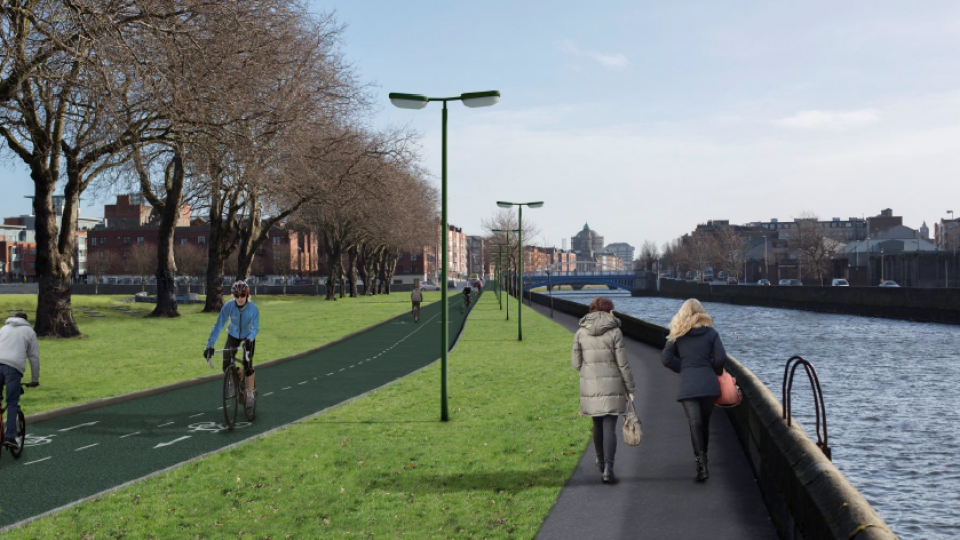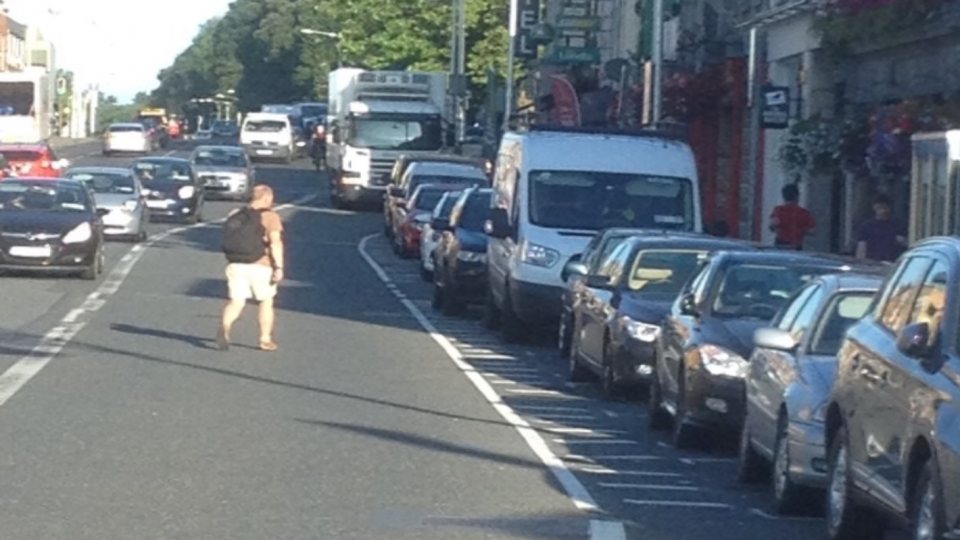Dublin Cycling Campaign strongly opposes Liffey Cycle Route backstreet detour
Dublin Cyling Campaign are disappointed in the latest option proposed by Dublin City Council for the potentially iconic ‘Liffey Cycle Route’. This latest option proposes to take the route away from the Quays between Church Street and Heuston, so can no longer be accurately titled the ‘Liffey Cycle Route. Read below why Dublin Cycling Campaign oppose this latest proposed solution
Response to Option 5 Proposal for Liffey Cycle Route – July 2016
1 Introduction
The route selection process for the proposed Point to Phoenix Park (P2P) or Liffey cycle route began in late 2012 over a 2 day workshop. This workshop prioritised a cycle route along the north quays of the River Liffey as being the best option, from a variety of different options. Further workshops and more detailed examination of potential routes by independent consultants confirmed a North Quays route as being the best option. A public consultation process in 2015 further confirmed the overwhelming support for this option.
Now in 2016, 4 years after the initial workshop, a major variation on the proposed North Quays route, which removes a large portion of the cycle route from the quays to parallel back streets, is being put forward as the preferred solution. **Dublin Cycling Campaign strongly opposes this proposed Option 5 solution. **
Dublin Cycling Campaign urges Dublin City Council to prioritise cycling, walking and public transport and revert to a full riverside design for the Liffey Cycle Route for its entire length. This is the key element of the design that was overwhelmingly endorsed by the public in last year’s public consultation. It would be
- an important and iconic statement by the City,that recognises the need to encourage active travel,
- endorsing the Vision outlined in the most recent draft of Dublin City’s Development Plan 2016-2022, which is: ‘a socially inclusive city of urban neighbourhoods, all connected by an exemplary public transport, cycling and walking system’
- a recognition of a people centred vision for our future city
- recognising the economic and social success of many similar developments in other European cities.
2 The Importance of a full length Riverside Route
The prioritising of a riverside cycling (and walking) facility will unlock this congested and often dangerous route so that cycling works for families, leisure cycling, and commuters alike. Dublin needs to move beyond viewing the Liffey as simply a transport corridor. The original concept of reimagining of the quays over the full length will enable this, while simultaneously
- Increasing capacity for the city’s growing population;
- Improving air quality and reducing noise pollution;
- Boosting tourism;
- Attracting the world’s leading companies and business
- Improving the health of all Dubliners.
The proposed circuitous diversion away from the riverside (option 5) moves the route away from its pleasant setting, away from basic desire lines, and adds numerous extra junctions and conflict points between cycling and pedestrians and delivery vehicles. For these reasons this proposed design will not attract biking commuters and other bike users, will cause problems for cargo bike/delivery bike users and will do little to encourage newcomers to cycling. It will set a low bar, undermining future plans for cycling in Dublin.
3 Reasons to reject Option 5
Practical design reasons why Option 5 from Phoenix Park to Church Street is a poor choice for cyclists include:
- Lack of buffer space between cycle route and general carriageway all along this off-river section of route.
- Badly designed linkages with existing Phoenix Park cycle tracks.
- Conflicts with the loading and parking bay at the Criminal Courts of Justice.
- Loss of scarce footpath width on the north side of Parkgate Street.
- Conflict with high demand for loading and parking on north side of Parkgate Street (see image below).
- Loss of priority at minor business entrances on Parkgate Street.
- Conflict with delivery and coach loading at the Aisling Hotel.
- Crossing the Luas tracks west of the Croppies Park at an inappropriate angle.
- Loss of a footpath behind the Civil Defence HQ and Croppy Acre Park.
- Conflicts with pedestrians at the Museum Luas stop.
- Poor linkages with the critical Heuston transport hub and Heuston South Quarter
- Conflict with apartment car park access on Benburb Street.
- Extra turning conflicts with vehicles on the shared Luas/carriageway sections.
- Loss of a busy newly constructed footpath at Smithfield pinch point.
- Dangerous cycle path design contrary to National Cycle Manual at Smithfield pinch point.
- Lack of linkages to Father Mathew Bridge.
- Loss of river frontage and directness of route
- Loss of an iconic statement by City on transport priorities for the future
The following table further illustrates the shortcomings of option 5, showing the number of junctions on the different cycle route options between Phoenix Park and Church Street
[ See PDF version below ]
4 Riverside Route is Feasible
Dublin Cycling Campaign maintains that the essence of an Option with a full riverside cycle route and Bus Priority, and the relocation of the Croppies Acre down to the river is feasible, and the best option for Dublin City. The options for the diversion of general traffic need to be further explored. There will obviously be a need to design specifically for pinch points around Mellowes Bridge, due to the international heritage constraints. This could be done by all or some of these options below:
- Narrowing the proposed cycle route over a short distance, as happened on sections of the Grand Canal cycleway.
- Merging main traffic lanes for a short section
- Diverting pedestrians on to the building side of the North Quays for a section, enabling the use of the existing riverside pathway width.
- Diverting general vehicular traffic along Benburb St for an agreed distance.
- Consideration of other possibilities, including new bridges across Liffey
The movement of the Croppies Acre park down to the riverside, and the incorporation of the present Civil Defence depot into the design, would be a wonderful idea and the creation of a further major public open space for the people of Dublin. Dublin Cycling Campaign understands that archaeological investigations have revealed that no human remains exist in this area, and thus there should be no impediment with redesigning this area to create this potentially wonderful new open amenity as part of this iconic project.
If absolutely necessary, the existing road configuration in this area could also be maintained and used for the proposed route, if other constraints in relation to the use of Croppies Acre park prove insurmountable.
A further option to be considered is that Dublin City Council could assert the strategic nature of this transport corridor and the proposed route and explore the option of having the route declared as critical national infrastructure. This could possibly allow necessary derogations from the ‘heritage constraints’ to consider the widening of the roadway at Mellowes Bridge and a sensitive design approach. Derogations can be obtained by applying directly through An Bord Pleanala under the strategic infrastructure provisions of the Planning and Development (Strategic Infrastructure) Act 2006 (the 2006 Act), which came into effect on 31st January 2007.
5 Conclusions
- The proposed Option 5 diversion, between Church St and Heuston, for the iconic Liffey Cycle Route is not an acceptable solution for cyclists, and downgrades the role of cycling as part of the transport solution for Dublin City.
- Dublin Cycling Campaign maintains that a full riverside cycle route is feasible within thevarious constraints, but will involve some different design choices and transport prioritisation. Dublin Cycling Campaign is happy to enter into detailed discussion with City officials on this matter.
- The Liffey Cycle Route should ideally live up to its name, and be designed as a full riverside route, in order to realise its potential.
Help us do more for cycling in Dublin by becoming a member!


